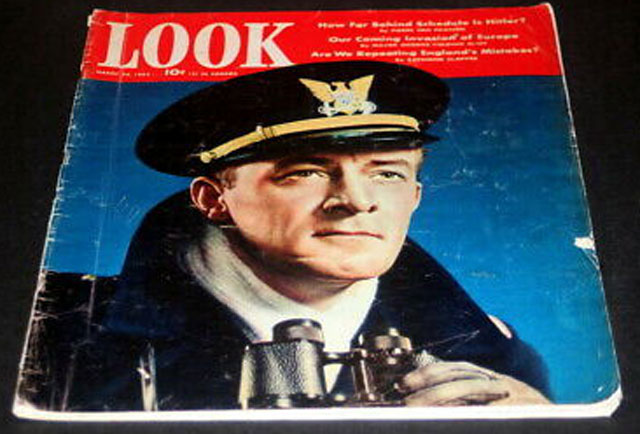Tuesday 24 March 1942
 |
| Japanese soldiers setting out on a mission, Nippon News, Number 094, Nippon News, No. 094, March 24, 1942. |
The Japanese are eager to set their final conquest of the Philippines in motion, and General Masaharu Homma is under heavy pressure to move fast. Today, the Japanese begin a concentrated air and artillery bombardment of the Allied positions on Bataan and Corregidor. Japanese bombers also attack at night for the first time. All is not bad for the Allies, however. Fortuitously, a Filipino patrol captures orders from a dead Japanese officer. They spell out a plan to take Mount Samac on 26 March. This geographical feature divides the 1st and 2nd US Corps sectors and is a potential weak spot in the line. Having this warning enables the US Army to prepare its defenses in the area.
 |
| The Los Angeles Examiner of 24 March 1942 trumpets the relocation scheme for Japanese-Americans which is just starting to gear up. |
In the Solomon Islands, Australian coastwatchers Don McFarland, Martin Clemens, and Ken Hay set up a post on the isolated west coast of Guadalcanal at the town of Lavor.
 |
| Western media remains quite positive about the war situation despite a very grim actual situation. Kingston (Jamaica) Gleaner, 24 March 1942. |
The German 11th Army is still locked in a tight stalemate with General Kozlov's 51st Army on the Kerch Peninsula of the Crimea. The weather has improved enough for the Luftwaffe to build up its forces after replenishment back in the Reich. Today, KG 51 attacks Tuapse again to try to isolate Kozlov's troops. The Junkers Ju 88s sink transports Yalta and Neva. Despite this, Kozlov is preparing a third offensive to break through the Parpach Narrows. This is planned for 26 March 1942.
 |
| Pravda, 24 March 1942. |
Training and routine patrols often lead to losses for a variety of reasons: fatigue, poor maintenance, bad weather, inexperience, etc. Today, an RAF No. 820 Squadron Albacore crashes on takeoff at Habston in the Orkneys. The three crewmen are lost.
 |
| Staff at the Securities and Exchange Commission headquarters in Philadelphia, March 24, 1942. |
U-123 (Kptlt. Reinhard Hardegen), on its 8th patrol out of Lorient, continues a very successful patrol. At 03:01, U-123 torpedoes and sinks 8138-ton British tanker Empire Steel northeast of Bermuda (east of Delaware). This follows a 5-hour pursuit of the tanker. Hardegen gets impatient when the tanker refuses to sinks and surfaces to fire nine rounds from his deck gun. There are 39 deaths and eight survivors, who are picked up by the US tug Edmund J. Moran, which spots them while towing another vessel, 5184-ton passenger vessel Robert E. Lee.
German minesweeper M-3615 hits a mine and sinks just outside the port of Ostend. There are 15 deaths. The wreck was salvaged and scrapped in 1950.
 |
| Everything is okay on that pesky war front, with the Japanese already losing according to the 24 March 1942 Nassau (Long Island, NY) Daily Review-Star. |
Anglo/Sino Relations: Relations between the British and Chinese remain tense due to the Tulsa Incident, but British General Harold Alexander, General Officer Commanding Burma Army, and Generalissimo Chiang Kai-shek meet to talk things over.
The 23rd Bombardment Squadron (Heavy) of the 7th Air Force transfers within Hawaii from Hickam Field to Mokuleia. The B-17s will fly patrols from there.
The 91st Bombardment Squadron, 27 Bomber Group begins moving its A-24s from Brisbane, Australia, to Charters Towers. The ground echelon for this unit remains trapped in Bataan.
American Homefront: In San Diego, 20th Century Fox premieres "To the Shores of Tripoli" directed by H. Bruce Humberstone and starring John Payne, Maureen O'Hara, and Randolph Scott. The film is notable for being shot in Technicolor and having portions of the film shot at the Marine Corps Recruit Depot in San Diego. The film is a success and greatly aids Marine recruiting during World War II.
 |
| Look magazine, 24 March 1942. |
March 1942
March 1, 1942: Second Battle of Java Sea
March 2, 1942: Huge Allied Shipping Losses at Java
March 3, 1942: Japan Raids Western Australia
March 4, 1942: Second Raid On Hawaii
March 5, 1942: Japan Takes Batavia
March 6, 1942: Churchill Assaults Free Speech
March 7, 1942: British Defeat in Burma
March 8, 1942: Rangoon Falls to Japan
March 9, 1942: Japanese Conquest of Dutch East Indies
March 10, 1942:US Navy attacks Japanese Landings at Lae
March 11, 1942: Warren Buffett's First Stock Trade
March 12, 1942: Japan Takes Java
March 13, 1942: Soviets Attack In Crimea Again
March 14, 1942: The US Leans Toward Europe
March 15, 1942: Operation Raubtier Begins
March 16, 1942: General MacArthur Gets His Ride
March 17, 1942: MacArthur Arrives in Australia
March 18, 1942: Japan Attacks In Burma
March 19, 1942: Soviets Encircled on the Volkhov
March 20, 1942: "I Shall Return," Says MacArthur
March 21, 1942: Germans Attack Toward Demyansk
March 22, 1942: Second Battle of Sirte
March 23, 1942: Hitler's Insecurity Builds
March 24, 1942: Bataan Bombarded
March 25, 1942: Chinese Under Pressure in Burma
March 26, 1942: Win Or Die, Vows MacArthur
March 27, 1942: The Battle of Suusari
March 28, 1942: The St. Nazaire Commando Raid
March 29, 1942: The Free Republic of Nias
March 30, 1942: Japanese-Americans Off Bainbridge Island
March 31, 1942: Japanese Seize Christmas Island
2020




